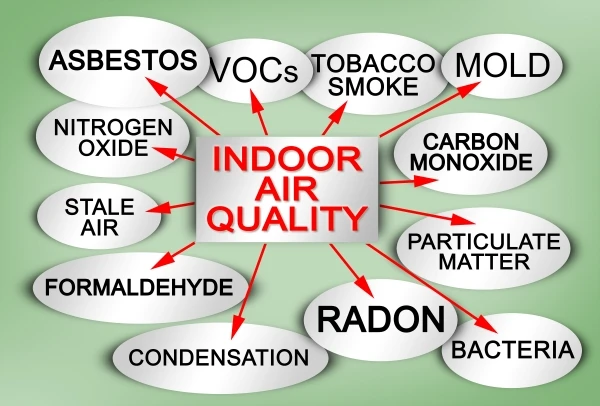
According to the Environmental Protection Agency (EPA), the average American spends 90% of their time indoors. With so much time spent inside, it’s easy to see just how important indoor air quality (IAQ) is to your household, and your health.
While you may not be able to control your air quality outdoors or at your place of work, the choices you make inside your home have a direct impact on the quality of the air you breathe.
This article will explain how you can improve the quality of the air your family breathes by removing potential pollutants, increasing ventilation, and making good air quality choices.
Common Indoor Air Pollutants and Their Sources
While many household items can cause indoor air pollution, some of the most dangerous and most common are:
- Asbestos: toxic fire-retardant found in older homes and businesses. Its presence can cause fatal lung disease.
- Biological pollutants: pollen, animal dander, and dust mites.
- Lead (Pb): Often found in paint, lead can be present in wall paint and paint on old toys. While we typically think of led paint exposure as ingestion, it may contaminate the air during paint removal or renovation. If exposed for long periods, lead can be extremely harmful and cause long-term health and developmental problems.
- Wood Smoke: From indoor wood-burning fireplaces in a home release fine-particle matter that’s small enough to enter the lungs and cause coughing or induce asthma.
- Volatile Organic Compounds (VOCs): A group of chemical compounds commonly found in paints, waxes, varnishes, and cleaning solutions. VOCs emit gasses which have been liked to both short- and long-term health conditions.
- Pesticides: Rated for interior or exterior residential use, or used on neighboring farm fields and commercial entities, pesticides aren’t just toxic to insects and rodents, but people too.
- Radon (Rn): A radioactive gas that is also odorless and colorless. Most commonly found in basements, sometimes at levels that can cause lung cancer. Radon is the second-leading cause of lung cancer behind smoking.
- Tobacco Smoke: Not only is tobacco smoke a risk to the smoker, but tobacco smoke may also stain your home and expose your loved ones to the harmful effects of secondhand smoke.
It’s unlikely that anyone would seek to buy a product that is a known pollutant. The problem is that many common building materials, cleaning solutions, and even time-honored traditions like enjoying a wood burning fireplace, may pose a risk to your pulmonary health.
Related Topic: Signs You Have Poor Indoor Air Quality
Reduce Indoor Air Pollution
Because harmful ingredients are found in popular household products and common building materials and furnishings, it’s vital for homeowners to read ingredients labels, research new purchases, find trustworthy suppliers, and always ask questions.
How to Prevent Indoor Air Pollution
It’s difficult to avoid all potential indoor air pollutants, but homeowners can take steps to limit their exposure by:
- Having homes built before 1980 inspected for asbestos and lead paint before beginning any renovations.
- Equipping homes with carbon monoxide and smoke detectors.
- Having homes inspected for radon at the time of purchase.
- Always using low-VOC and nontoxic paints, waxes, varnishes, glues, and cleaning materials according to the manufacturer’s instructions and in a well-ventilated space.
- Buying furniture, carpeting, rugs, drapery, and insulation that’s made with nontoxic materials and doesn’t off-gas fumes.
- Purchasing or making your own nontoxic laundry detergents, fabric softeners, surface cleaning products, etc.
- Investing in a high-quality air purifier and replacing air filters quarterly.
- Maintaining an appropriate level of humidity throughout your home.
Why Eliminating Common Sources of Indoor Air Pollution is Important
Indoor air pollution may cause irritation, shortness of breath, or aggravate asthma and other respiratory conditions. Long-term exposure to poor indoor air can cause more severe problems, affecting your heart, causing chest pain, and reducing resistance to infections. It’s critical for the health of yourself and your household to not only improve indoor air quality but to prevent future pollution. Prioritize your home’s IAQ, and you will breathe easier—literally!
Related Topic: Is Your Home Well Ventilated?
How to Improve Indoor Air Quality at Home
With so much time spent indoors, you want to have the best air quality possible. While many homeowners have pets and wood-burning fireplaces, there are ways to mitigate some air quality repercussions.
To keep your air as pure as possible, you should:
- Engage in professional mitigation of dangerous or damaged materials, including those damaged by smoke or water.
- Change your AC, furnace, and humidifier filters regularly (at least once per quarter.
- Have your air ducts professionally cleaned.
- Improve home ventilation and have gas-fired home appliances (stoves, furnaces, heaters, dryers) maintained yearly by a professional.
- Use the range hood to vent fluorocarbons when using a gas cooktop.
- Use bathroom fans to vent shower humidity, especially in the summer months.
- Have soft surfaces including upholstered furniture, rugs, and carpeting professionally cleaned to remove pet dander and dust mites.
- Buy and use a hygrometer on each level of your home to monitor the humidity level to prevent the growth of mold spores.
Need professional fire, smoke, or mold damage remediation? Turn to Rainbow International, a member of the Neighborly family of brands for assistance in mitigating damage and restoring your property.
Breathe Easy with Help from Aire Serv
Improving indoor air quality at home begins with simple steps like product research and inspections, but there’s more that can be done. From air duct cleaning to air purification systems, our services help homeowners breathe easy. To learn more about how you can imp improve your home’s air quality, or to get started today, call Aire Serv or request an appointment online.

